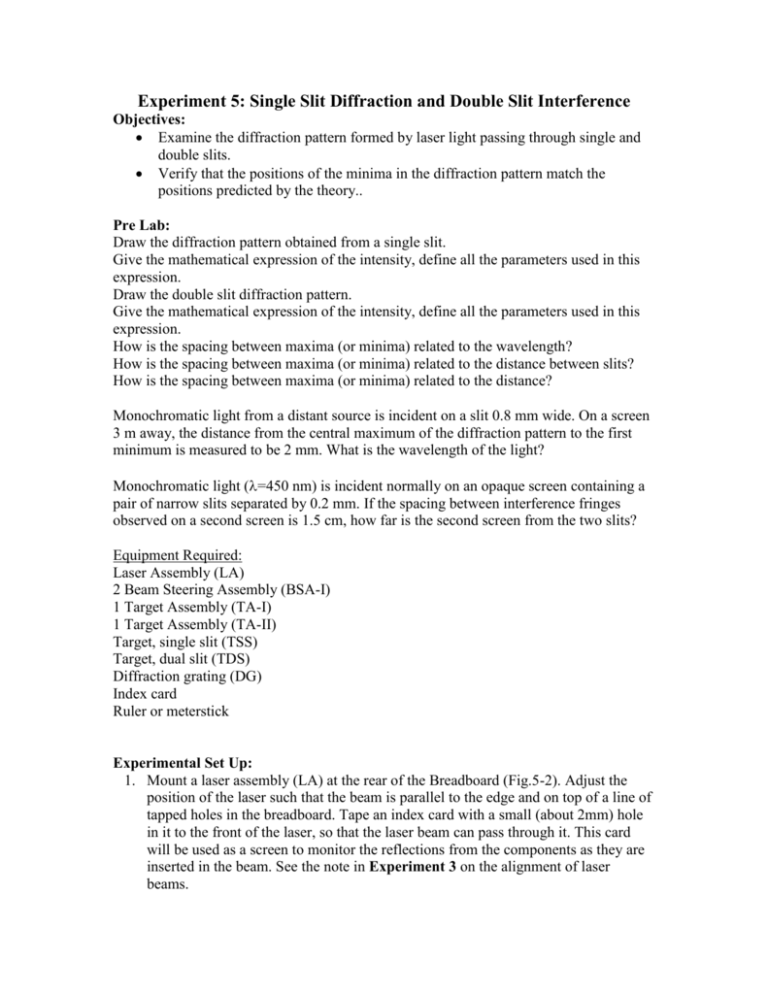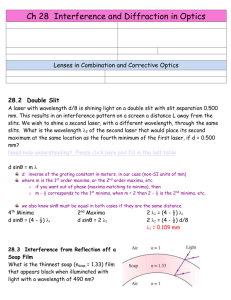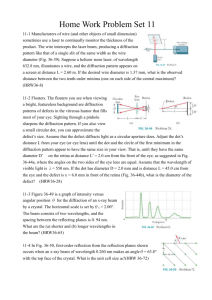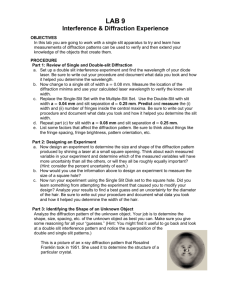Experiment 5: Single Slit Diffraction and Double Slit Interference
advertisement

Experiment 5: Single Slit Diffraction and Double Slit Interference Objectives: Examine the diffraction pattern formed by laser light passing through single and double slits. Verify that the positions of the minima in the diffraction pattern match the positions predicted by the theory.. Pre Lab: Draw the diffraction pattern obtained from a single slit. Give the mathematical expression of the intensity, define all the parameters used in this expression. Draw the double slit diffraction pattern. Give the mathematical expression of the intensity, define all the parameters used in this expression. How is the spacing between maxima (or minima) related to the wavelength? How is the spacing between maxima (or minima) related to the distance between slits? How is the spacing between maxima (or minima) related to the distance? Monochromatic light from a distant source is incident on a slit 0.8 mm wide. On a screen 3 m away, the distance from the central maximum of the diffraction pattern to the first minimum is measured to be 2 mm. What is the wavelength of the light? Monochromatic light (=450 nm) is incident normally on an opaque screen containing a pair of narrow slits separated by 0.2 mm. If the spacing between interference fringes observed on a second screen is 1.5 cm, how far is the second screen from the two slits? Equipment Required: Laser Assembly (LA) 2 Beam Steering Assembly (BSA-I) 1 Target Assembly (TA-I) 1 Target Assembly (TA-II) Target, single slit (TSS) Target, dual slit (TDS) Diffraction grating (DG) Index card Ruler or meterstick Experimental Set Up: 1. Mount a laser assembly (LA) at the rear of the Breadboard (Fig.5-2). Adjust the position of the laser such that the beam is parallel to the edge and on top of a line of tapped holes in the breadboard. Tape an index card with a small (about 2mm) hole in it to the front of the laser, so that the laser beam can pass through it. This card will be used as a screen to monitor the reflections from the components as they are inserted in the beam. See the note in Experiment 3 on the alignment of laser beams. 2. Mount a beam steering assembly (BSA-I) approximately 4 inches in from the far corner of the breadboard (Fig. 5-2). Adjust the height of the mirror mount until the beam intersects the center of the mirror. Then rotate the post in the post holder until the laser beam is parallel to the left edge and the surface of the optical breadboard. 3. Place a second beam steering assembly (BSA-I) in line with the laser beam at the lower left corner of the optical breadboard, (Fig. 5-2). Rotate and adjust the mirror mount until the laser beam is parallel to the front edge and the surface of the optical breadboard. 4. Place an index card in a modified target holder assembly (TA-II) and set it at the end of the breadboard so that the beam hits the center of the card. 5. Mount a TA-I five inches to the right of the last beam steering mirror and four inches in from the laser beam. This will be the holder for parts TSS and TDS. Part A: Single Slit Diffraction 6. Carefully place the TSS (single slit- 0.002 in. wide) into the TA-I. Adjust the mount such that the laser beam strikes the target approximately in the center. WARNING The target will reflect a large percentage of the beam. 7. Adjust the last beam steering mirror such that the laser beam fills the slit. This can best be accomplished by viewing the back side of the target from the 45° and looking for a bright red glow. This will occur when the laser beam is illuminating the slit. 8. Watch the write card. Carefully adjust the last beam steering mirror to produce the brightest image. You should see a bright central band with several dimmer bands on each side. This is the single diffraction pattern. Mark on the index card the locations of as many dark bands as you can easily see. Note that the central band is larger than the sidebands. a. Measure the distance between the center of the dark bands on both sides of the central band and the distance from the slit to the index card. b. Calculate the angle at the slit between the central peak and the first dark band. c. If the wavelength of the He-Ne laser is 633 nm, determine the width of the slit from your calculations. Part B: Young’s Double Slit Experiment 1. A second and related experiment can be performed with the previous set-up. Replace the TSS with a TDS (dual slit – 0.002 in. wide with 0.008 in. spacing) target and the index card used as the observation screen. a. Measure the slit to index card distance, R. 2. The diffraction pattern: a. Describe the diffraction pattern. b. What is the connection between this diffraction pattern and the single slit diffraction pattern? c. Mark the locations of the minima x1, x2... of these closely spaced fringes. Calculate the average separation Δx = x1-x2. Also mark the location of the minimum of the large band (the position where the interference fringes disappear). 3. Calculate the fringe separation from Δθ = Δx / R and record it in your notebook. Calculate the slit separation using this value of Δθ and the wavelength of the laser (λ = 633 nm). Does your answer agree with the real value of the slit separation? Explain. 4. Take a card or the edge of a ruler and carefully insert it in front of one of the true slit. This takes a little practice. a. If you do it right, what will you see? b. Explain Part C: Diffraction Grating Higher order diffraction patterns exist for 3,4,5...equally spaced slits. Eventually, the number of slits becomes very large and the results approach the diffracting grating. Most high resolution instruments for determining the transmission or reflection characteristics of optical materials and coatings use some forms of a grating. 1. Mount a diffraction grating (DG) in the TA-1 and illuminate it with the laser beam. Mount a new index card in the TA-II and locate it behind DG, so that a number of diffraction orders can be seen. 2. Move the TA-II away from DG until only few dots remain on the screen and their separations are easily measured. Mark the locations of the diffraction orders on the card and label each with the order (0 for the undiffracted beam). Measure the distance from DG to the screen. 3. Calculate the diffraction angles from the measurements. Note the angles are large enough that you cannot use any small angle approximation. You must use the inverse tangent to arrive at the angle. 4. The groove separation or grating constant, for this grating is found by taking the reciprocal of the grating frequency, which is 13,400 grooves per inch. From the groove separation and the angular measurement for several orders, determine the wavelength of the helium-neon laser. Compare it to 633 nm. Comment on your result.








